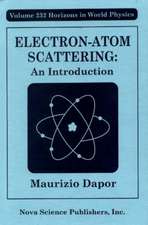Introducing Molecular Electronics: Lecture Notes in Physics, cartea 680
Editat de Gianaurelio Cuniberti, Giorgos Fagas, Klaus Richteren Limba Engleză Hardback – 5 dec 2005
| Toate formatele și edițiile | Preț | Express |
|---|---|---|
| Paperback (1) | 402.17 lei 6-8 săpt. | |
| Springer Berlin, Heidelberg – 22 oct 2010 | 402.17 lei 6-8 săpt. | |
| Hardback (1) | 409.30 lei 6-8 săpt. | |
| Springer Berlin, Heidelberg – 5 dec 2005 | 409.30 lei 6-8 săpt. |
Din seria Lecture Notes in Physics
- 19%
 Preț: 423.99 lei
Preț: 423.99 lei - 17%
 Preț: 360.73 lei
Preț: 360.73 lei -
 Preț: 429.22 lei
Preț: 429.22 lei - 17%
 Preț: 427.62 lei
Preț: 427.62 lei - 17%
 Preț: 460.25 lei
Preț: 460.25 lei -
 Preț: 427.96 lei
Preț: 427.96 lei -
 Preț: 481.93 lei
Preț: 481.93 lei - 17%
 Preț: 494.64 lei
Preț: 494.64 lei -
 Preț: 281.90 lei
Preț: 281.90 lei - 17%
 Preț: 493.20 lei
Preț: 493.20 lei - 17%
 Preț: 426.72 lei
Preț: 426.72 lei -
 Preț: 365.15 lei
Preț: 365.15 lei -
 Preț: 374.52 lei
Preț: 374.52 lei -
 Preț: 407.98 lei
Preț: 407.98 lei - 20%
 Preț: 428.12 lei
Preț: 428.12 lei - 15%
 Preț: 593.73 lei
Preț: 593.73 lei - 15%
 Preț: 528.13 lei
Preț: 528.13 lei -
 Preț: 493.12 lei
Preț: 493.12 lei - 17%
 Preț: 425.68 lei
Preț: 425.68 lei -
 Preț: 280.65 lei
Preț: 280.65 lei -
 Preț: 163.41 lei
Preț: 163.41 lei - 18%
 Preț: 726.59 lei
Preț: 726.59 lei -
 Preț: 394.84 lei
Preț: 394.84 lei - 15%
 Preț: 709.63 lei
Preț: 709.63 lei - 15%
 Preț: 623.90 lei
Preț: 623.90 lei - 20%
 Preț: 476.91 lei
Preț: 476.91 lei - 15%
 Preț: 428.05 lei
Preț: 428.05 lei -
 Preț: 342.78 lei
Preț: 342.78 lei - 18%
 Preț: 851.93 lei
Preț: 851.93 lei -
 Preț: 346.61 lei
Preț: 346.61 lei -
 Preț: 391.57 lei
Preț: 391.57 lei - 15%
 Preț: 633.16 lei
Preț: 633.16 lei -
 Preț: 451.71 lei
Preț: 451.71 lei - 5%
 Preț: 1497.80 lei
Preț: 1497.80 lei -
 Preț: 374.85 lei
Preț: 374.85 lei -
 Preț: 380.07 lei
Preț: 380.07 lei - 15%
 Preț: 516.14 lei
Preț: 516.14 lei - 15%
 Preț: 583.78 lei
Preț: 583.78 lei - 15%
 Preț: 510.95 lei
Preț: 510.95 lei -
 Preț: 469.71 lei
Preț: 469.71 lei -
 Preț: 388.90 lei
Preț: 388.90 lei - 15%
 Preț: 500.24 lei
Preț: 500.24 lei -
 Preț: 386.52 lei
Preț: 386.52 lei - 15%
 Preț: 472.88 lei
Preț: 472.88 lei -
 Preț: 424.27 lei
Preț: 424.27 lei -
 Preț: 380.07 lei
Preț: 380.07 lei - 15%
 Preț: 500.01 lei
Preț: 500.01 lei - 15%
 Preț: 501.96 lei
Preț: 501.96 lei
Preț: 409.30 lei
Nou
Puncte Express: 614
Preț estimativ în valută:
78.34€ • 81.47$ • 65.55£
78.34€ • 81.47$ • 65.55£
Carte tipărită la comandă
Livrare economică 15-29 martie
Preluare comenzi: 021 569.72.76
Specificații
ISBN-13: 9783540279945
ISBN-10: 3540279946
Pagini: 536
Ilustrații: XIX, 517 p.
Dimensiuni: 155 x 235 x 34 mm
Greutate: 0.92 kg
Ediția:2005
Editura: Springer Berlin, Heidelberg
Colecția Springer
Seria Lecture Notes in Physics
Locul publicării:Berlin, Heidelberg, Germany
ISBN-10: 3540279946
Pagini: 536
Ilustrații: XIX, 517 p.
Dimensiuni: 155 x 235 x 34 mm
Greutate: 0.92 kg
Ediția:2005
Editura: Springer Berlin, Heidelberg
Colecția Springer
Seria Lecture Notes in Physics
Locul publicării:Berlin, Heidelberg, Germany
Public țintă
ResearchCuprins
Theory.- Foundations of Molecular Electronics – Charge Transport in Molecular Conduction Junctions.- AC-Driven Transport Through Molecular Wires.- Electronic Structure Calculations for Nanomolecular Systems.- Ab-initio Non-Equilibrium Green’s Function Formalism for Calculating Electron Transport in Molecular Devices.- Tight-Binding DFT for Molecular Electronics (gDFTB).- Current-Induced Effects in Nanoscale Conductors.- Single Electron Tunneling in Small Molecules.- Transport through Intrinsic Quantum Dots in Interacting Carbon Nanotubes.- Introducing Molecular Electronics: A Brief Overview.- Introducing Molecular Electronics: A Brief Overview.- Experiment.- Contacting Individual Molecules Using Mechanically Controllable Break Junctions.- Intrinsic Electronic Conduction Mechanisms in Self-Assembled Monolayers.- Making Contacts to Single Molecules: Are We There Yet?.- Six Unimolecular Rectifiers and What Lies Ahead.- Quantum Transport in Carbon Nanotubes.- Carbon Nanotube Electronics and Optoelectronics.- Charge Transport in DNA-based Devices.- Outlook.- CMOL: Devices, Circuits, and Architectures.- Architectures and Simulations for Nanoprocessor Systems Integrated on the Molecular Scale.
Textul de pe ultima copertă
This volume presents a summary of our current understanding of molecular electronics combined with selected state-of-the-art results at a level accessible to the advanced undergraduate or novice postgraduate. This single book comprises the basic knowledge of both theory and experiment underpinning this rapidly growing field. Concepts and techniques such as density functional theory and charge transport, break junctions and scanning probe microscopy are introduced step-by-step and are subsequently used in specific examples. The text addresses a wide range of systems including molecular junctions made of single-molecules, self-assembled monolayers, carbon nanotubes and DNA.
Caracteristici
Features basic knowledge of both theory and experiment Includes supplementary material: sn.pub/extras















